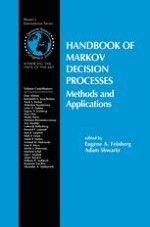Eugene A. Feinberg Adam Shwartz This volume deals with the theory of Markov Decision Processes (MDPs) and their applications. Each chapter was written by a leading expert in the re spective area. The papers cover major research areas and methodologies, and discuss open questions and future research directions. The papers can be read independently, with the basic notation and concepts ofSection 1.2. Most chap ters should be accessible by graduate or advanced undergraduate students in fields of operations research, electrical engineering, and computer science. 1.1 AN OVERVIEW OF MARKOV DECISION PROCESSES The theory of Markov Decision Processes-also known under several other names including sequential stochastic optimization, discrete-time stochastic control, and stochastic dynamic programming-studiessequential optimization ofdiscrete time stochastic systems. The basic object is a discrete-time stochas tic system whose transition mechanism can be controlled over time. Each control policy defines the stochastic process and values of objective functions associated with this process. The goal is to select a "good" control policy. In real life, decisions that humans and computers make on all levels usually have two types ofimpacts: (i) they cost orsavetime, money, or other resources, or they bring revenues, as well as (ii) they have an impact on the future, by influencing the dynamics. In many situations, decisions with the largest immediate profit may not be good in view offuture events. MDPs model this paradigm and provide results on the structure and existence of good policies and on methods for their calculation.
